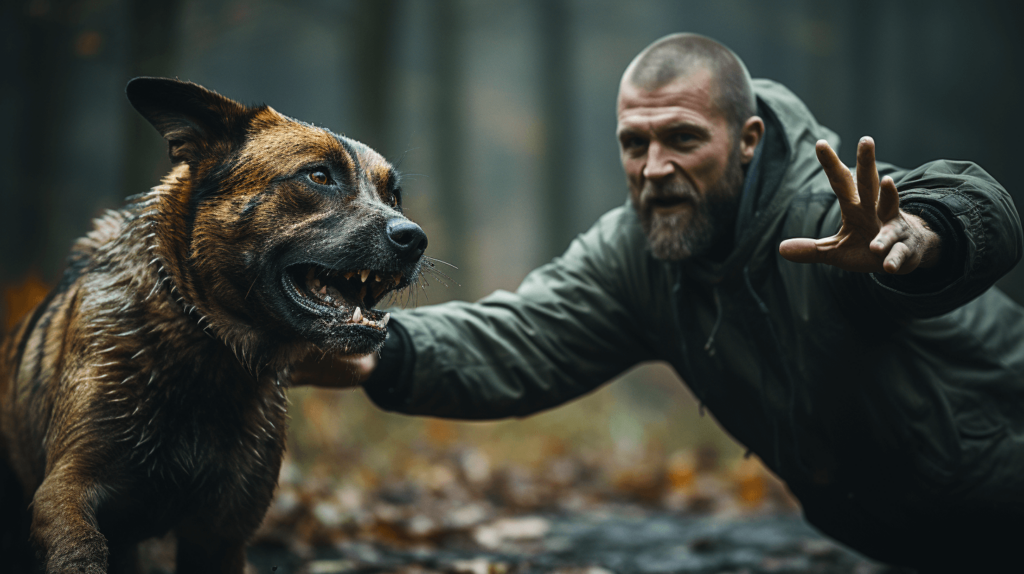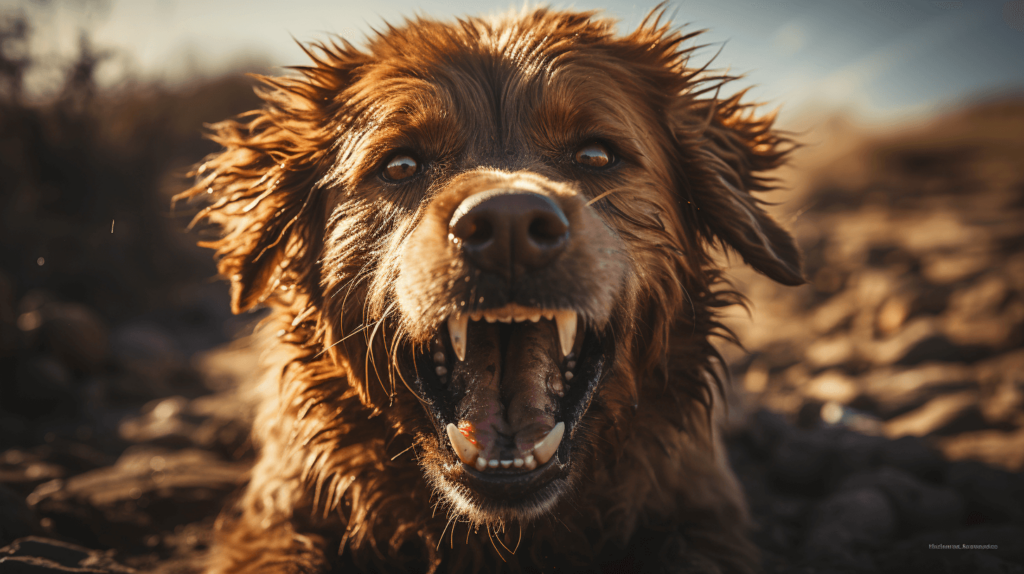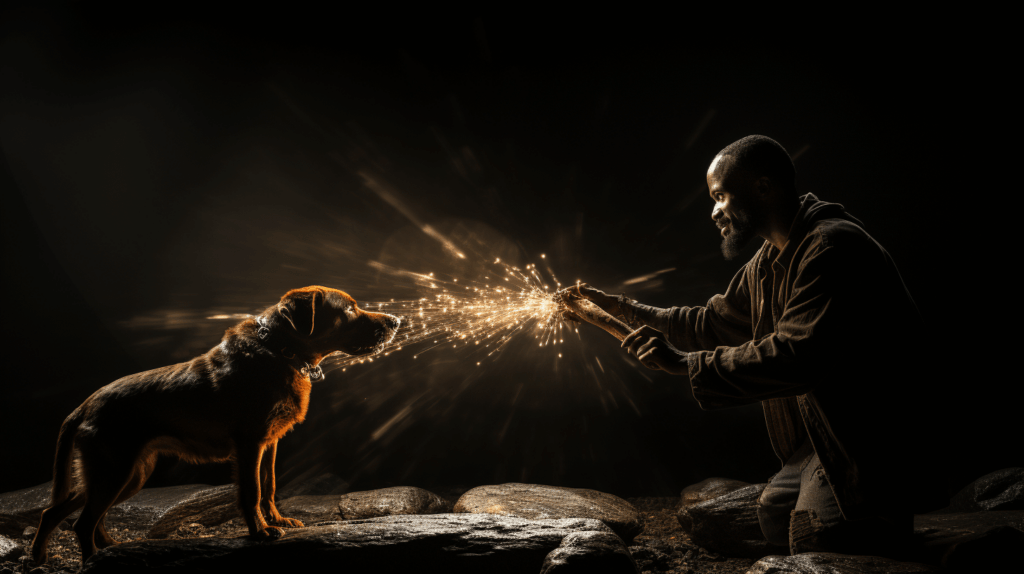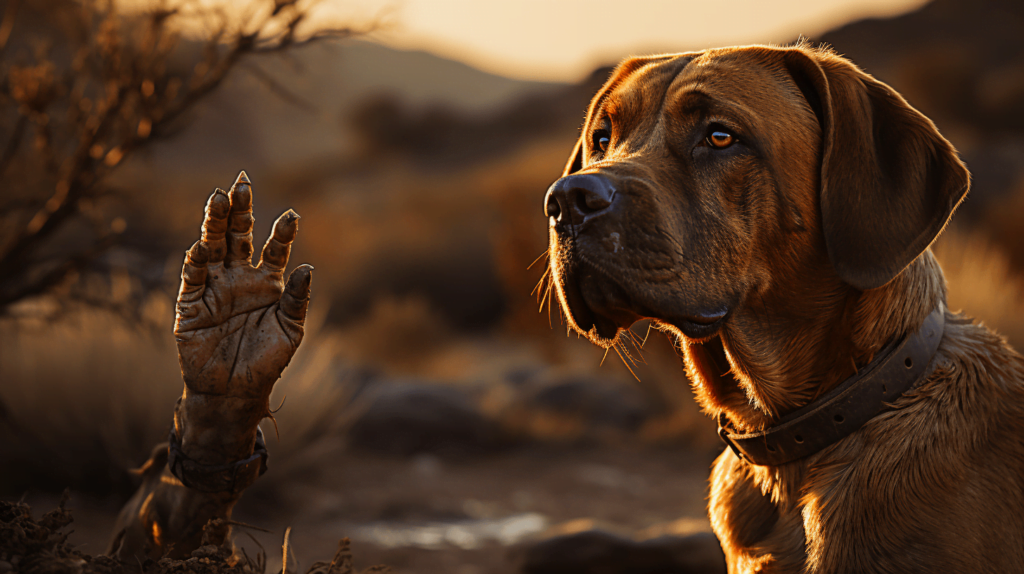Tales from the Tides
Part 1:
The Encounter with the Brown Dog

In the small coastal town of Norham, where the sea met the sand, lived a man of contemplative nature, named Harold. One afternoon, as he strolled along the beach, he noticed a curious scene that caught his attention. A brown dog, its coat shimmering under the sun, was growling aggressively at its owner.
At first, Harold dismissed it, attributing the canine’s behavior to a temporary show of disobedience. In psychology, a dog often symbolizes basic instincts, emotions, or desires that are expressed without filters. In esotericism, it stands for loyalty and the protective aspect of our nature. Harold wondered if this scene represented an inner struggle within himself, where his aggressive instincts were trying to overpower his controlled self.
As days passed, Harold observed the dog’s increasingly aggressive behavior, but the owner still maintained control. It was like witnessing a constant battle between one’s primal instincts and the ability to keep them in check. Harold felt a strange connection to the scene, like it was a mirror reflecting his own internal struggles. The aggressive dog could be his uncontrolled emotions and instincts, while the owner could represent his controlled, rational self.
Feeling a sense of duty, Harold decided to intervene. Maybe helping the dog could symbolize aiding his own conflicting emotions, bringing balance and harmony within himself. So, with an apprehensive heart, he approached the dog and its owner.
Part 2:
The Clash with the Primal Instincts

As Harold moved closer, his heart pounded in his chest, yet he was resolved to intervene. Perhaps, he thought, by helping the dog, he might find a way to reconcile his own internal turmoil.
As soon as he reached out his hand, the dog, filled with aggression, bit him on the leg and hand. The sharp pain jolted him, but it was the shock of the act that truly shook him. In the world of dream interpretation and symbolism, being bitten by a dog represents betrayal or a sense of being blindsided by someone or something. Harold pondered on this symbolism, wondering if his subconscious was trying to tell him about his own unaddressed issues or uncontrolled instincts that were hurting him.
Fighting through the pain, Harold searched for a piece of wood lying nearby. He picked it up, intending to fend off the dog. In esoteric symbolism, wood often signifies the process of growth, change, and transformation. It felt apt to Harold, as he was indeed in the midst of an internal transformation.
As he swung the wood, trying to keep the dog at bay, Harold found himself in a physical and symbolic struggle with the dog, his primal instincts. The relentless dog kept coming towards him, but Harold fought back, refusing to let his aggressive instincts overpower him. It was a battle between his raw, uncontrolled emotions and his desire for personal growth and transformation.
Part 3:
The Retreat into the Sea

The tussle between Harold and the dog mirrored the man’s internal struggle. Each swing of the wooden stick was a determined attempt to tame the uncontrolled instincts within him. But the dog – the embodiment of his unchecked emotions – continued to advance.
Harold, however, remained steadfast. With each swing of the wood, he affirmed his commitment to personal growth, his intent to gain control over his primal instincts. Gradually, the aggressive dog started to retreat, its relentless advances slowing down. Harold could sense his determination making an impact.
Finally, to Harold’s surprise, the brown dog retreated completely, running off into the sea. The sight of the dog disappearing into the vast expanse of water held profound symbolism for Harold. Water in psychological and esoteric symbolism often represents emotions and the unconscious. The dog’s retreat into the sea could symbolize Harold’s aggressive instincts being absorbed back into his unconscious, no longer posing an immediate threat to his sense of control.
The struggle was over. Harold felt a strange sense of relief and calmness. He had confronted his primal instincts, symbolized by the brown dog, and had succeeded in pushing them back into the recesses of his unconscious mind.
His encounter with the brown dog, painful and challenging as it was, had forced him to confront and control his unchecked emotions. He had taken the first crucial steps towards personal growth, towards becoming a more balanced, controlled individual. It was a journey that began with an aggressive brown dog and ended with newfound wisdom and self-understanding.
Part 4:
The Vigilance over the Subconscious

Even after the dog disappeared into the sea, Harold realized his journey was far from over. The symbolic retreat of the dog into the sea – the reabsorption of his aggressive instincts into his unconscious – did not signal the end. Instead, it opened up a new challenge: vigilance over his subconscious.
Harold understood that the aggressive instincts might be submerged, but they were not entirely defeated. Just as a dog can swim back to shore, these instincts could resurface, perhaps in more subtle and surreptitious ways.
Harold knew he had to be vigilant. Vigilance meant self-awareness – continuously observing his emotions, reactions, and behaviors. It was about acknowledging the presence of these instincts in his subconscious, not denying or ignoring them.
To maintain this vigilance, Harold began to practice mindfulness, regularly taking quiet moments to reflect upon his thoughts and actions. It was his way of keeping a gentle watch over the shore of his subconscious, ready to spot if the brown dog – his primal instincts – tried to return.
He also found solace in sharing his experiences with others, understanding that conversations could provide insights into his own subconscious workings. These discussions served as another way to keep his subconscious in check, allowing him to spot any signs of his old, unchecked instincts taking over.
By maintaining vigilance over his subconscious, Harold ensured that he was not controlled by his unaddressed issues or uncontrolled instincts. It was a journey of constant growth, of unceasing transformation – a journey that began with a confrontation with an aggressive brown dog and continued with a man’s unending vigilance over his subconscious self.
Part 5:
The Color of Instinct and the Choice of Engagement

In the days following his encounter with the brown dog, Harold pondered two crucial aspects of his experience. The first was the symbolism of the brown color of the dog. The second was the question of his choice to engage with the dog in the first place.
Brown, in psychological symbolism, often represents stability, honesty, practicality, and commitment. When associated with the dog, Harold understood it as the representation of raw, honest instincts within himself – aggressive but grounded in their nature. It was a reminder that these instincts were a natural part of his psyche, neither inherently good nor evil. They could lead to strength and commitment if harnessed correctly, or result in chaos if left unchecked.
Coming to the second question, Harold questioned his choice of engagement with the dog. Was it necessary for him to involve himself in the conflict between the dog and its owner? He reflected on the principle that not every conflict demands our involvement.
But the dog’s aggression, its symbolism, and the resonance with his own inner struggle had drawn him in. He realized that he had chosen to intervene not just for the dog or its owner but also for his personal growth. It was a conflict that mirrored his inner battle, and confronting it was like confronting a part of himself.
Yet, Harold acknowledged that one must pick their battles wisely. Not every external conflict reflects an internal one. And not every struggle needs our intervention. Discernment is a key aspect of personal growth. One must understand when to step forward and when to step back.
This introspection brought a new layer of understanding to Harold’s experience. The brown dog had been more than an aggressive animal. It was a symbol of his primal instincts, an embodiment of a part of his psyche. His choice to engage with the dog was an acceptance of his internal battle and a step towards personal growth. But his reflection on this decision reminded him of the importance of discernment and wise decision-making in life’s ongoing journey.







